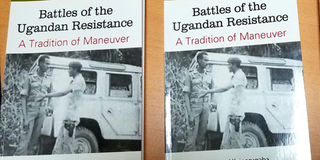
Author: Muhoozi Kainerugaba
Title: Battles of the Ugandan Resistance: A Tradition of Maneuver
Availability: Aristoc Bookshop
Price: Shs20,000
Published: 2010
Pages: 223
Philip Matogo
We often use the word ‘maneuver’ in comical ways. For instance, you may be standing in a buffet line, waiting to serve yourself the mother of all helpings.
However, the line is so long. So what do you do?
You “maneuver” your way to the head of the line in order to “attack” several plates-worth of everything.
Well, that sort of maneuver would only get you so far in the context of actual warfare, where life and limb are savaged by the enemy.
Gen Muhoozi Kainerugaba’s book, or monograph as he calls it, “Battles of the Ugandan Resistance: A Tradition of Maneuver” will reveal the secrets of how you can get ahead. Not in the buffet line, but on the battlefield. “Maneuver was a central element of the resistance war. All the key battlefield successes in Masindi, Kabamba III, Kembogo and Kampala, were obtained through the application of maneuver,” Kainerugaba writes.
Maneuver warfare, or manoeuvre warfare, is a military strategy which emphasises movement, initiative and surprise to achieve a position of advantage.
This maneuverist approach to war was enshrined in the way the National Resistance Army (NRA) conducted its battle with the second government of Milton Obote. It also characterised the People’s war or protracted people’s war the NRA favoured to rise from the crimson-green ravages of the Luwero Triangle.
A People’s War was a Maoist military strategy first developed by the Chinese communist revolutionary leader, Mao Zedong (1893–1976).
It has three phases: guerilla warfare, mobile warfare; and regular/conventional warfare.
The audacious attack on Kabamba owed its phasic actuality to guerilla warfare, the overrunning of Masindi fell into phase two and the capture of Kampala was expressive of conventional warfare.
What is striking in this book is not Kainerugaba’s recounting of the so called resistance war. To the contrary, it is the elevation of his thought above the conclusions the president of Uganda, Yoweri Museveni, makes.
Namely, he doubts the wisdom of conjuring engineering solutions to solve all human problems. Instead, he channels Shaka Zulu to demonstrate how a warrior must be an artist in order to not be a murderer.
Although valuing the importance of science and technology in warfare, Kainerugaba notes “a continuing military tradition (sustained by the practice of recording military events is equally important.”
This is where the arts, in the shape of history and not Maths, come into play. By this token, he is able to reference the treatise “On War” by military thinker, Carl von Clausewitz. Again, Kainerugaba enriches his own ideas with ideas propounded in Robert Leonhard’s book The Art of Maneuver.
Leonhard identifies three ways of maneuver: pre-emption or ‘seizing an opportunity before the enemy does’, dislocation, which refers to rendering the enemy’s strength ineffective and disruption, which is “the practice of defeating the enemy by attacking his centre of gravity.”
Setting forth the virtues of “Command Push” maneuver, a style of controlling military maneuver favouring centralised control and the “Recon-pull” command style which uses reconnaissance to determine routes suitable for maneuver, the author recognises, as Clausewitz did, that strategy is simple, but that does not make it simple.




